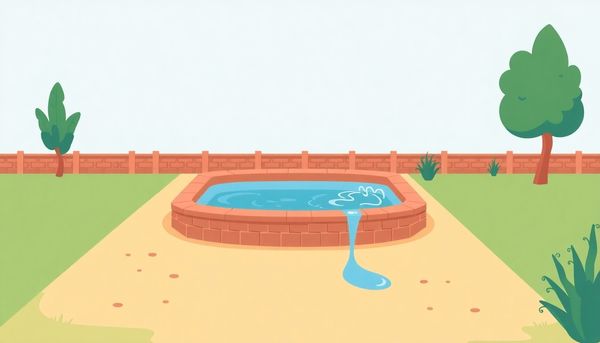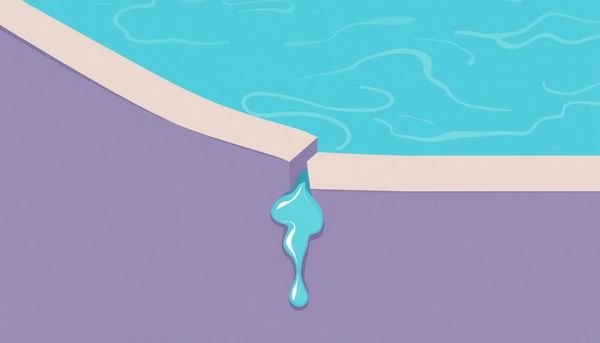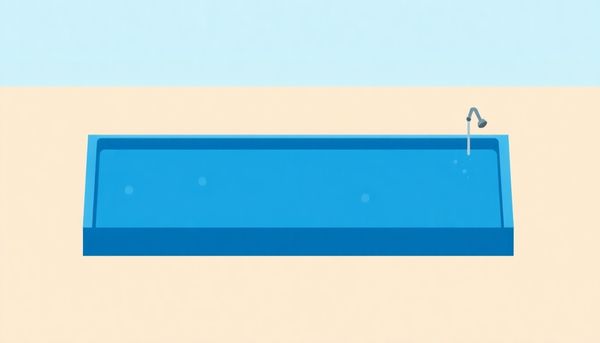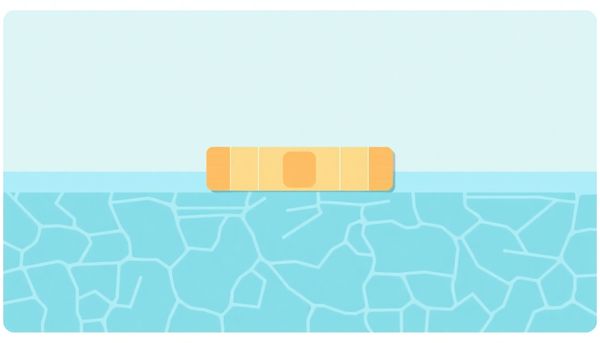DIY Pool Leak Detection: Save Money and Fix Water Loss Fast
January 05th, 2025
January 05th, 2025
Owning a pool is one of life's finer pleasures until an unexpected dip in water levels signals trouble. A leak might seem like a minor inconvenience at first, but left unchecked, it can turn into a costly repair. What if you could tackle this issue yourself, saving both time and money? By understanding a few essential techniques, you can detect pool leaks with more confidence and efficiency.
Years ago, an unusually high water bill led me to the realization that my backyard oasis was losing water faster than a bucket with a hole. With no prior experience in pool maintenance, I was determined to find the leak without calling in an expensive professional. Armed with simple tools and a methodical approach, I transformed from a pool owner into a detective, discovering the source of the problem and restoring my pool's integrity.
The process of pool leak detection doesn't demand advanced skills or specialized tools. A sharp eye and a bit of patience often suffice. By inspecting the pool's surface, checking equipment fittings, and using a few time-tested tricks like the bucket test, you can pinpoint the leak. This guide aims to empower you with practical advice and step-by-step instructions, turning what seems like a daunting task into a manageable one. As you embark on this journey, you'll gain not only peace of mind but also a deeper appreciation for your swimming retreat.

Tracing the source of a pool leak can seem like unraveling a mystery. Start your investigation by ruling out common culprits, such as evaporation or plumbing system glitches. A quick glance at the filter area can often reveal leaks around the pump, filter, or heater connections. These areas, while easily accessible, can also be the root of the problem, particularly if an O-ring has worn out over time.
Once you've crossed plumbing issues off your list, it's time to delve into the pool itself. The Bucket Test is a straightforward way to discern whether your water loss is due to evaporation or an actual leak. Position a bucket filled with pool water on a step, mark the water levels inside and outside the bucket, and check back in 24 hours. If the pool level has dropped more than the bucket's, you've got a leak to hunt down.
For pinpoint accuracy, the Ink Test is your next ally. This test requires a dye or leak finder to identify the leak's precise location. Carefully apply the dye near suspected areas like cracks, fittings, or seams, and observe where it flows. The dye will gravitate towards the leak, making it visible.
Should your investigation lead you to suspect leaks at the bottom of the pool, arm yourself with goggles and take a dive. Precision is key here; remain as still as possible to track the dye's direction without interference. This hands-on approach not only saves time but also equips you with the exact knowledge needed to address the problem effectively.
In the realm of pool maintenance, ensuring that your plumbing and equipment are in top-notch condition is crucial. A hidden leak can often masquerade as mere evaporation, but a closer look at your plumbing might reveal the real culprit. Begin by giving your filter system an attentive examination. This includes the pool pump, filter, heater, and chlorinator. Every joint and O-ring in these components deserves scrutiny, as they are common leak hotspots. Just last summer, a neighbor discovered a sneaky drip from a loose connection on their pump that was costing gallons of water daily.
While these areas are relatively easy to check, don’t overlook the possibility of underground piping issues, especially for inground pools. Cracked pipes beneath the surface can be elusive, often leading to more significant problems if ignored. Before jumping to conclusions about subterranean leaks, conduct an evaporation test. The Bucket Test is a simple yet effective method: fill a bucket with pool water and place it on a step in the pool. Mark the water level inside the bucket and on the pool wall, then compare them after 24 hours. If the pool level drops more than the bucket level, a leak is likely.
Should these tests point to a leak in the plumbing, a professional’s expertise may be necessary. However, identifying visible issues early can save you a fortune and keep your pool running smoothly, ensuring you spend more time enjoying, rather than repairing, your backyard oasis.
Determining whether water loss in your pool is due to evaporation or a leak is crucial before delving into more complex diagnostics. Consider the Bucket Test, a simple yet effective method to differentiate between the two. Grab a large, sturdy bucket, and position it on the pool steps, ensuring its rim sits above the waterline. Fill the bucket with pool water to match the level outside. This setup allows you to compare the rate of water loss inside the bucket with that in the pool over 24 to 48 hours.
Should the water level in the pool drop more significantly than in the bucket, there's a strong indication of a leak. On the other hand, if both levels decrease at the same rate, evaporation is likely the culprit. Factors such as high temperatures, wind, and humidity can accelerate evaporation, making this test particularly handy in regions with extreme weather conditions.
For even more precision, consider marking the water levels inside and outside the bucket with waterproof tape. This visual aid minimizes guesswork, providing clear evidence of any discrepancies in water loss. Remember, patience is key. Conducting the test over a couple of days ensures more accurate results, helping you confidently proceed with further leak detection steps or rule out unnecessary repairs. It's a straightforward exercise, yet it can save you both time and money in the long run.
Discovering a leak in your pool liner often feels like a daunting task, but with the right approach, it becomes manageable and even rewarding. Start by assessing the condition of your vinyl liner. If it's generally in good shape and the rip is minor, a DIY repair can be both practical and cost-effective. However, consider the age and condition of your liner carefully; older liners become fragile and may need replacing sooner rather than later.
For small punctures, waterproof tape proves to be a handy tool. It's clear, UV-resistant, and can be overlapped for larger areas. While easy to apply, it's most effective for short-term fixes due to its tendency to peel over time. Another option is using peel-and-stick vinyl patches, specifically designed for pools. These patches can be applied directly underwater, offering a quick solution for minor damages.
For more extensive damage, a vinyl patch kit offers a more durable fix. These kits come equipped with larger patches and special adhesives that work effectively underwater. Although they require a bit more effort and skill, the long-term benefits are worth it.
Attempting these repairs yourself not only saves money but also deepens your understanding of your pool's maintenance needs. However, if your efforts don't yield the desired results or you suspect a more complex issue, consulting a professional can provide peace of mind and ensure your pool remains in top condition.

Understanding evaporation is crucial in the journey to pinpointing pool leaks. A common misstep among pool owners is mistaking regular water evaporation for a more serious problem. Every pool loses some water through evaporation, especially during hot summer days or in dry climates. But, assuming there's a leak can lead you down a rabbit hole of unnecessary repairs.
To ensure evaporation doesn’t deceive you, perform the simple Bucket Test. Fill a bucket with pool water and place it on a pool step, ensuring the water levels inside and outside the bucket are the same. Leave it for 24 hours without swimming or adding water to the pool. If the water level outside drops more than inside the bucket, you might indeed have a leak rather than mere evaporation. This straightforward test helps eliminate false alarms and saves both time and money in the process.
I remember a summer when I was frantically convinced my pool was leaking. It turned out to be nothing more than a particularly sunny week. The relief of discovering it was evaporation taught me the value of patience and simple diagnostics. Ensure to always start with ruling out evaporation before diving into more labor-intensive leak detection methods. This small step can be a massive leap in maintaining both your pool’s health and your peace of mind.
In the quest to uncover a potential pool leak, the initial challenge is to distinguish between an actual leak and the natural process of evaporation. Water seems to vanish overnight, making it easy to jump to conclusions. Before you delve into the realm of plumbing mishaps or structural damage, take a step back and consider the simplest explanation.
Begin by understanding that evaporation rates vary depending on several factors: climate, humidity, wind, and water temperature all play roles. On a hot day, your pool can lose up to a quarter-inch of water purely from evaporation. To test if evaporation is the sneaky culprit, try the classic Bucket Test. Grab a bucket, fill it with pool water, and place it on a pool step, ensuring the water level inside the bucket matches the pool's water level. Mark the water level on both the inside and outside of the bucket. Leave it for 24 hours and compare the levels. If the pool water has dropped more significantly than inside the bucket, a leak may be to blame.
Alternatively, the Ink Test can help pinpoint smaller leaks. With a steady hand, release a colored dye near suspected leak areas. Watch how the dye behaves; it will drift toward the source of the leak. By ruling out evaporation first, you streamline the process, saving time and unnecessary anxiety, all while gaining a clearer path to pinpointing pesky pool problems.
Exploring the hidden details of your pool equipment often reveals the source of a troublesome leak. Start your investigation by zeroing in on each component of your pool's filtration system. This means giving special attention to the pool pump, filter, heater, and any chlorination devices. Examine each connection closely, as even the smallest fissure in an O-ring or pipe joint can lead to significant water loss.
Consider the story of my neighbor, Sarah, who once faced an inexplicable drop in her pool's water level. After inspecting her equipment, she discovered a subtle leak in her pool heater’s connection, which was cleverly disguised by condensation. A quick fix with a replacement gasket saved her both money and frustration.
Don't overlook the not-so-obvious areas, such as underground piping, which might seem daunting at first. If you suspect an underground issue, look for damp spots around your pool area or unusual plant growth, as these can signal hidden leaks. For those with inground pools, persistent or unresolved issues may require a professional's touch to pressure test your plumbing lines.
Conclusively, while hunting for pool leaks yourself can be rewarding, understanding every nook and cranny of your pool equipment allows you not only to identify problems swiftly but also to appreciate the intricate workings keeping your backyard oasis thriving.
Finding a pool leak on your own can feel like searching for a needle in a haystack, but with a few simple DIY methods, you can narrow down the possibilities with confidence. The first approach involves the Bucket Test, a classic technique that helps distinguish water loss due to evaporation from an actual leak. All you need is a bucket, some water, and a marker. Start by filling the bucket with pool water and marking the water level inside and outside the bucket. Leave the bucket on the pool step for a day; if the pool water level drops more than the bucket water level, you likely have a leak.
For pinpointing leaks, the Ink Test is your go-to choice. With a syringe filled with dye, swim near suspected areas—like the pool floor or around fittings. Release the dye close to these spots and watch as it gravitates towards the leak. It's a fascinating method that requires patience and a steady hand, especially when underwater. Don't forget goggles for a clear view!
For those with vinyl liners, a good scan for visible tears is crucial. Keeping some waterproof tape handy for marking spots can be a lifesaver, as it helps in identifying issues and planning repairs. Remember, while these methods are efficient, if you ever feel out of your depth or the problem persists, seeking professional assistance might just save you time and trouble in the long run.

When tackling pool leaks, ensuring that the issue isn't related to evaporation is your first mission. To start, grab a common household item—a bucket. Fill it with pool water, and place it on a pool step so that the water level inside the bucket matches the pool’s surface. Over 24 hours, observe any discrepancies between the water levels inside and outside the bucket. If both levels drop equally, you can suspect evaporation. But, if the pool’s level decreases more significantly, it’s time to explore further for leaks.
Your intuition might guide you to inspect around the pool’s structure. This is where the Ink Test becomes your secret weapon. Add a few drops of food coloring or a specialized leak detection dye near suspected areas. Stay still as the dye dances through the water, tracing a path towards any leak. This method is particularly revealing around fixtures, lights, and cracks where leaks commonly lurk.
Don’t be surprised if you find yourself transforming into a sort of pool detective, employing these methods to zero in on hidden problems. With diligence and a little creativity, you’ll likely find the source of the leak without the immediate need for professional intervention. Just remember, while these tests can reveal a lot, consulting a pro is wise if the leak seems elusive or beyond a simple DIY fix.
Understanding where water is disappearing from your pool can be as elusive as catching a whisper on the wind. One common culprit, before you jump to conclusions about leaks, is simple evaporation. Each pool faces this natural phenomenon, influenced by factors like weather, humidity, and pool usage. A sunny day with a slight breeze can whisk away significant amounts of water, making it appear as though your pool has a leak when it doesn’t.
To accurately assess if evaporation is the root of your water loss, the tried-and-true Bucket Test offers a simple, yet effective solution. Begin by placing a bucket on a pool step, ensuring it’s partially submerged to mimic the pool’s water level. Fill the bucket with water to match the pool’s level and mark both the inside and outside water lines. After a day, compare the water levels inside the bucket with the pool’s water. If both levels drop equally, evaporation is to blame. A greater drop in the pool signals a potential leak.
Addressing evaporation can be as simple as using a pool cover or adjusting your water features to minimize splashing. These strategies not only conserve water but also maintain your pool’s chemical balance, saving you time and resources in maintenance. However, if discrepancies in the Bucket Test suggest a leak, then it’s time to roll up your sleeves and investigate further.
When it comes to pool leak detection, one often overlooked area is the maze of pipes and equipment that keep your pool running smoothly. Before assuming that the water loss is due to a tear in the lining or a crack in the structure, take a closer look at the plumbing and equipment connected to your pool. These components are prime suspects in many leak scenarios.
Start by thoroughly inspecting your filter system. Focus on the pool pump, filter, heater, chlorinator, and every O-ring or connection. Worn-out seals or loose fittings can easily lead to leaks. Take a moment to run your fingers along the joints and connections, feeling for any dampness which might indicate a slow leak. Homeowners often find a simple gasket replacement or tightening a fitting resolves the issue.
Next, consider the less visible plumbing. Underground pipes, especially in older or inground pools, can develop leaks over time due to ground shifting or age-related wear. If you suspect this, a pressure test by a professional might be necessary, though it can save you from chasing phantom leaks in the pool liner.
While inspecting, make sure to distinguish between regular evaporation and a possible leak. Mark the water level and monitor it over a few days. If you're still losing water, it's time to pinpoint the exact source using methods like the Bucket Test or the Ink Test. In any case, addressing equipment and plumbing first can often reveal quick fixes and save you from more extensive repairs.
Standing at the edge of your backyard swimming pool, you notice the water level isn’t quite where it was yesterday. Thoughts of costly repairs and hiring professionals might cross your mind, but before reaching for the phone, consider this: performing leak detection tests on your own could save you both time and money.
Begin with the basics. You’ll want to first rule out evaporation, a common culprit mistaken for leaks. A simple Bucket Test will help here. Fill a bucket with pool water nearly to the brim and place it on the pool steps, ensuring the water level inside the bucket matches the pool’s. Leave it for 24 hours. If the pool’s water line drops more than the bucket’s, a leak might be hiding below the surface.
For those slightly more elusive leaks, the Ink Test is your ally. Arm yourself with leak detection dye, available at most pool supply stores. With goggles on, slowly submerge and release a small amount of dye near suspected leak sites, like around fittings or skimmer edges. Watch carefully; if the dye swirls rapidly toward a crack or seam, you’ve found your leak.
These DIY tests offer a practical approach to diagnosing pool leaks, allowing you to pinpoint problems before they escalate. Whether it’s a simple patch or a more serious repair, identifying the leak is the first step to safeguarding your aquatic oasis. Taking the time to investigate on your own could make all the difference in maintaining your pool’s health and your peace of mind.

Dealing with a leaky vinyl pool liner can feel like a daunting task, but it doesn't have to be. Imagine the satisfaction of handling the issue yourself, saving both time and money. Vinyl liners are not only cost-effective, but they can also be patched up with relative ease if you know what you're doing. First, assess whether the damage is worth repairing or if it's time to consider a replacement. Older liners tend to become brittle and more prone to future leaks, so weigh your options carefully.
Once you decide to repair, there are three main methods to choose from, each suitable for underwater application. Waterproof tape is an easy, budget-friendly option that works well for minor leaks. Despite its simplicity, it may not hold up long term, especially in high-stress areas like around stairs or fittings. For a more secure fix, vinyl patches specifically designed for pools can be pressed into place and offer better durability. These are pre-cut and straightforward to apply, ideal for small punctures.
For larger holes, a vinyl patch kit is your best bet. These kits include larger pieces of vinyl and a special adhesive that allows for a more permanent repair. It's a bit more involved, but definitely worth the effort if you're seeking a longer-lasting solution. Remember, there's no need to drain your pool; all these methods can be applied underwater, preserving your pool’s integrity and saving you from unnecessary complications.
Detecting a pool leak can feel like a daunting task, but with a bit of patience and the right approach, it’s entirely manageable. Before jumping into the water, start by checking the pool's filtration system. Leaks often occur at the pump, filter, or heater connections, which are thankfully easy to access. It’s also essential to ensure that the water loss isn’t due to evaporation—this can be tested using the simple Bucket Test.
Once you’re certain the issue isn’t evaporation, it’s time to zero in on the pool itself. The Ink Test is particularly useful here. This involves using a pre-filled dye tester to identify leaks in the pool's structure. Slowly release the dye near suspected areas; if there’s a leak, the dye will be drawn towards it. For deeper locations, don a pair of goggles and carefully observe where the dye flows.
Structural leaks in concrete or gunite pools, especially around the skimmer, may require plaster repair. Meanwhile, vinyl liners can often be patched with specialized kits. But remember, patches are temporary solutions. As vinyl ages, it becomes more susceptible to tears. Check areas around stairs or fittings—these spots are under constant stress from water pressure.
While DIY methods can save money, sometimes professional help is necessary, especially for underground plumbing issues. Just know that taking the first steps yourself can often resolve the issue without breaking the bank.
Detecting a pool leak often begins with a simple yet crucial step: a thorough inspection of the plumbing and equipment. This process not only involves a visual examination but also a methodical assessment of each component. Begin by scrutinizing the filter system area, where leaks are most accessible and thus easier to address. Check each piece, from the pool pump to the chlorinator, for suspicious signs of moisture or water loss. Pay particular attention to O-rings and connections, notorious for developing minor leaks that can go unnoticed.
While visible components can be relatively straightforward to inspect, underground plumbing poses a more complex challenge, especially for inground pools. These concealed areas can hide leaks in cracked pipes. If your pool is losing water at an alarming rate, yet there's no visible wetness around the equipment, it might be time to consider the possibility of a subterranean issue. Before jumping to conclusions, however, conduct an evaporation test to distinguish between natural water loss and an actual leak.
Once evaporation is ruled out, methods such as the Bucket Test or the Ink Test can help pinpoint the leak’s location. These tests are simple, cost-effective, and often utilize everyday household items. For any pool owner, mastering these inspection techniques is invaluable. Not only can they save time and money, but they also empower you with the knowledge needed to tackle potential pool problems head-on.
Selecting the appropriate repair method for a pool leak is akin to choosing the right tool for a job; nuances matter, and the path you choose can save you both time and resources. Firstly, understanding the nature of your pool is crucial. For instance, a vinyl liner pool will call for different tactics than a concrete or gunite pool. Vinyl tends to crack less frequently but when it does, patches or vinyl kits are your best bet. They are relatively easy to apply and can be done underwater, sparing you from draining the pool.
Concrete or gunite pools, however, may develop cracks at stress points such as where the skimmer meets the wall. Here, plaster repair becomes necessary. These repairs are more labor-intensive but offer a robust solution for structural issues. Always have waterproof tape on hand as a temporary fix. It’s not a long-term solution but can provide a stop-gap until a more permanent fix is applied.
When tackling larger repairs, a vinyl patch kit with underwater adhesive provides longevity. Yet, if your pool’s plumbing is the culprit, the challenge intensifies, especially if pipes are underground. In such cases, calling a professional to pressure test the lines might be the best course of action. Remember, each situation is unique, so take a moment to assess your pool's specific needs before diving into repairs.

Approaching the task of patching leaks underwater might initially seem daunting, but with the right tools and mindset, it's a challenge that can be tackled safely and effectively. Start by gathering essential supplies: waterproof adhesive, a patch kit suited to your pool’s material, and a good pair of goggles. Each tool is vital, transforming you into a pool repair pro without the hefty price tag of professional services.
Diving in, don your goggles and take a deep breath. This isn't just about the repair itself; it's about precision. In the underwater world, even a small movement can send dye and debris swirling, confusing your repair efforts. Therefore, approaching the leak with the patience of a seasoned diver will help ensure accuracy. Use a pre-filled dye tester to confirm the leak's exact location, watching the dye drift toward the problem area like a whispered secret.
Once the leak is identified, the real fun begins. If your pool has a vinyl liner, cut a patch slightly larger than the tear. Apply adhesive generously, then, with a steady hand, press the patch firmly over the leak. Smooth out any air bubbles as they can compromise the seal. In concrete or gunite pools, ensure the surface is clean before applying the patch.
Consider this moment an opportunity to bond with your pool, ensuring its longevity and integrity. While professional services are an option, there's a special satisfaction in knowing you've handled it on your own.
Every pool owner knows the frustration of watching water levels mysteriously drop, but pinpointing the source of a leak can feel like looking for a needle in a haystack. Before diving into elaborate tests, it's essential to rule out common culprits that might masquerade as leaks. Begin by examining your pool's plumbing system. The filter area, including pumps, heaters, and chlorinators, often harbors hidden leaks. Carefully inspect connectors and O-rings, as these spots are notorious for allowing water to escape.
Not all leaks are visible, though. Underground piping in inground pools can develop cracks, which might require professional attention. However, before assuming the worst, it's a good idea to test whether you're merely losing water to evaporation. Simple methods like the Bucket Test—comparing water loss in a bucket and the pool—can help distinguish between evaporation and a genuine leak.
Once evaporation is ruled out, focus on narrowing down potential leak locations. The Ink Test is an effective DIY approach: use leak finder dye to trace the flow of water near suspected areas. This technique is particularly handy for detecting structural leaks, such as those around skimmers or underwater fittings. Remember, leaks can be deceptive, often originating from places least expected, so thoroughness and patience are key. With a keen eye and a methodical approach, you’ll be well on your way to solving the mystery of your pool’s disappearing water.
Tackling a pool leak on your own can feel daunting, but with a little bit of knowledge and some simple tools, you can become your own detective. One of the first DIY methods to pinpoint a leak is the Bucket Test. This straightforward approach helps determine if you're losing water through evaporation or if there's a more substantial issue. Fill a bucket with pool water and place it on a pool step, ensuring the water level inside the bucket matches the pool's water level outside. After a day or two, compare the levels. If the pool water level has dropped more significantly than the bucket's, you might have a leak.
For those pesky, hard-to-find leaks, the Ink Test can be your hero. Equipped with a syringe filled with leak detection dye, you'll want to slowly introduce the dye near suspected areas, like cracks or seams. Watch closely as the dye will be drawn towards the source of the leak, uncovering its secret hiding spot. It’s essential to perform this test on a calm day with minimal water movement to ensure accuracy.
Remember, the key to successful DIY pool leak detection is patience and a keen eye. By methodically checking each area and using these tests, you'll likely save yourself a few hundred dollars and the headache of water loss. Should things get complicated, don't hesitate to consult a professional for those tough-to-reach or underground leaks.

This article provided insights into maintaining your pool. Start your pool care journey today!
Want to become a pool maintenance expert? Our free Pool School course covers everything you need to know about pool care. From basic maintenance to advanced troubleshooting, you'll learn how to:
Join over 10,000 pool owners who have already transformed their pool care routine. Get started with our free Pool School course today!